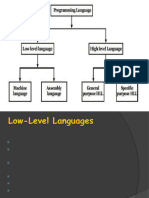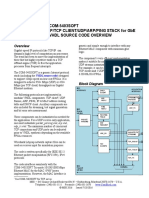Programming Languages
Uploaded by
Dilendra BhattProgramming Languages
Uploaded by
Dilendra BhattProgramming Languages In all over the world, language is the source of communication among human beings.
Different countries/regions have different languages. Similarly, in order to communicate with the computer user also needs to have a language that should be understood by the computer. For this purpose, different languages are developed for performing different types of work on the computer. Basically, languages are divided into two categories according to their interpretation. There are two major types of programming languages. These are Low Level Languages and High Level Languages. Low Level languages are further divided in to Machine language and Assembly language. Low Level Languages The term low level means closeness to the way in which the machine has been built. Low level languages are machine oriented and require extensive knowledge of computer hardware and its configuration. (a) Machine Language Machine Language is the only language that is directly understood by the computer. It does not needs any translator program. We also call it machine code and it is written as strings of 1s (one) and 0s (zero). When this sequence of codes is fed to the computer, it recognizes the codes and converts it in to electrical signals needed to run it. For example, a program instruction may look like this: 1011000111101 It is not an easy language for you to learn because of its difficult to understand. It is efficient for the computer but very inefficient for programmers. It is considered to the first generation language. It is also difficult to debug the program written in this language. Advantage
1.
The only advantage is that program of machine language run very fast because no translation program is required for the CPU.
Disadvantages It is very difficult to program in machine language. The programmer has to know details of hardware to write program. 2. he programmer has to remember a lot of codes to write a program which results in program errors. 3. It is difficult to debug the program.
1.
(b) Assembly Language It is the first step to improve the programming structure. You should know that computer can handle numbers and letter. Therefore some combination of letters can be used to substitute for number of machine codes. The set of symbols and letters forms the Assembly Language and a translator program is required to translate the Assembly Language to machine language. This translator program is called `Assembler. It is considered to be a second-generation language. Advantages: 1. The symbolic programming of Assembly Language is easier to understand and saves a lot of time and effort of the programmer. 2. It is easier to correct errors and modify program instructions. 3. Assembly Language has the same efficiency of execution as the machine level language. Because this is one-to-one translator between assembly language program and its corresponding machine language program. Disadvantages: 1. One of the major disadvantages is that assembly language is machine dependent. A program written for one computer might not run in other computers with different hardware configuration. 2. Since it is machine dependent therefore programmer should have the knowledge of the hardware also. HIGH LEVEL LANGUAGES You know that assembly language and machine level language require deep knowledge of computer hardware where as in higher language you have to know only the instructions in English words and logic of the problem irrespective of the type of computer you are using. Higher level languages are simple languages that use English and mathematical symbols like +, , %, / etc. for its program construction. You should know that any higher level language has to be converted to machine language for the computer to understand. Higher level languages are problem-oriented languages because the instructions are suitable for solving a particular problem. For example COBOL (Common Business Oriented Language) is mostly suitable for business oriented language where there is very little processing and huge output. There are mathematical oriented languages like FORTRAN (Formula Translation) and BASIC (Beginners All-purpose Symbolic Instruction Code) where very large processing is required.
Thus a problem oriented language designed in such a way that its instruction may be written more like the language of the problem. For example, businessmen use business term and scientists use scientific terms in their respective languages. Advantages of High Level Language Following are the advantages of a high level language: 1. 2. 3. 4. 5. 6. 7. User-friendly Similar to English with vocabulary of words and symbols Therefore it is easier to learn. They require less time to write. They are easier to maintain. Problem oriented rather than 'machine' based. Program written in a high-level language can be translated into many machine language and therefore can run on any computer for which there exists an appropriate translator. 8. It is independent of the machine on which it is used i.e.Programs developed in high level language can be run on any Computer Disadvantages of High Level Language
A high-level language has to be translated into the machine language by a translator and thus a price in computer time is paid. 2. The object code generated by a translator might be inefficient Compared to an equivalent assembly language program
1.
You might also like
- Types of Computer Languages With Their Advantages and Disadvantages50% (4)Types of Computer Languages With Their Advantages and Disadvantages3 pages
- Computer & Programming Fundamentals Unit-3No ratings yetComputer & Programming Fundamentals Unit-328 pages
- Lecture8 Intro To Machine and Assembly LanguageNo ratings yetLecture8 Intro To Machine and Assembly Language7 pages
- Continuation - Levels of Programming LanguagesNo ratings yetContinuation - Levels of Programming Languages10 pages
- Difference Between High Level and Low Level LanguagesNo ratings yetDifference Between High Level and Low Level Languages8 pages
- Types of Programming Languages: 1. Low Level LanguageNo ratings yetTypes of Programming Languages: 1. Low Level Language14 pages
- Introduction To Programming: 1.1. What Is Computer Programming?No ratings yetIntroduction To Programming: 1.1. What Is Computer Programming?73 pages
- Lecture 1 - Introduction To Programming LanguagesNo ratings yetLecture 1 - Introduction To Programming Languages5 pages
- Lecture 7 Machine and Assembly LanguagesNo ratings yetLecture 7 Machine and Assembly Languages20 pages
- Types of Computer Language Machine LanguageNo ratings yetTypes of Computer Language Machine Language3 pages
- Programming Languages and Program Development ToolsNo ratings yetProgramming Languages and Program Development Tools15 pages
- APznzaaip5uGeuGsyxmbBKMS5dJbrpF_QmUXUrJB7wyc8tilkXgEq2Etur-0g3wTzwMR8cK1ZBtgLQWqd-w4kQ2srt9U0NVaxn0WVyNbi-C0gchqRNq3N7HO18sjh9mavbAIaCHbxEdPAVq4ujqFOLOdW4sMZVVLqjoRFMUne-zABVHjxLWWI5tiSWwG2RPazC2OmzRM6eYmNo ratings yetAPznzaaip5uGeuGsyxmbBKMS5dJbrpF_QmUXUrJB7wyc8tilkXgEq2Etur-0g3wTzwMR8cK1ZBtgLQWqd-w4kQ2srt9U0NVaxn0WVyNbi-C0gchqRNq3N7HO18sjh9mavbAIaCHbxEdPAVq4ujqFOLOdW4sMZVVLqjoRFMUne-zABVHjxLWWI5tiSWwG2RPazC2OmzRM6eYm25 pages
- System Software and Programming Techniques 1No ratings yetSystem Software and Programming Techniques 15 pages
- ICT316_SWE316_Introduction to Programming LectNotes Nov2024No ratings yetICT316_SWE316_Introduction to Programming LectNotes Nov202419 pages
- Assembly Language and High Level Language PDFNo ratings yetAssembly Language and High Level Language PDF13 pages
- PRE - BENG 2007/2008 Lesson 3 Language/SoftwareNo ratings yetPRE - BENG 2007/2008 Lesson 3 Language/Software8 pages
- Chapter - 1 Topic - Computer Languages Computer LanguagesNo ratings yetChapter - 1 Topic - Computer Languages Computer Languages5 pages
- Programming Logic and Design: Ms. Kaycee R. Mendez Virtual TeacherNo ratings yetProgramming Logic and Design: Ms. Kaycee R. Mendez Virtual Teacher12 pages
- Chapter 1 - Intro to Computer programmingNo ratings yetChapter 1 - Intro to Computer programming10 pages
- Programming Language Ss1 (Computer Studies)No ratings yetProgramming Language Ss1 (Computer Studies)10 pages
- COMPUTER PROGRAMMING FOR KIDS: An Easy Step-by-Step Guide For Young Programmers To Learn Coding Skills (2022 Crash Course for Newbies)From EverandCOMPUTER PROGRAMMING FOR KIDS: An Easy Step-by-Step Guide For Young Programmers To Learn Coding Skills (2022 Crash Course for Newbies)No ratings yet
- Industrial Automation & Instrumentation: November 16, 2017No ratings yetIndustrial Automation & Instrumentation: November 16, 201772 pages
- 1 3 B.E / B.Tech. Practical End Semester Examinations, April / May 2019100% (1)1 3 B.E / B.Tech. Practical End Semester Examinations, April / May 20193 pages
- Data Communication & Networking MCQs Set-1 ExamRadarNo ratings yetData Communication & Networking MCQs Set-1 ExamRadar6 pages
- Summary Project Pengadaan Barang Dan Jasa Out Site Plan Roll Out Residential My Republik Jakarta Utara, Jakarta Barat & Jakarta PusatNo ratings yetSummary Project Pengadaan Barang Dan Jasa Out Site Plan Roll Out Residential My Republik Jakarta Utara, Jakarta Barat & Jakarta Pusat14 pages
- CSCE 612: VLSI System Design: Instructor: Jason D. BakosNo ratings yetCSCE 612: VLSI System Design: Instructor: Jason D. Bakos14 pages
- A2SV G5 - Bitwise Operation - With Code-MergedNo ratings yetA2SV G5 - Bitwise Operation - With Code-Merged59 pages
- Sitecore MVC ViewContext Stack Diagram and Introduction100% (1)Sitecore MVC ViewContext Stack Diagram and Introduction2 pages
- Connection Guide of The MOTOTRBO Radio To The Radioserver As A Control Station (Using The PMKN4147A Programming Cable and A Cable With The HLN9457 Connector)100% (1)Connection Guide of The MOTOTRBO Radio To The Radioserver As A Control Station (Using The PMKN4147A Programming Cable and A Cable With The HLN9457 Connector)10 pages
- Data Structures and DBMS For CAD Systems - A ReviewNo ratings yetData Structures and DBMS For CAD Systems - A Review9 pages
- Cisco Touch 10 Room Control Toggle Button HelpNo ratings yetCisco Touch 10 Room Control Toggle Button Help4 pages
- Application of Computers in Handling The AccountsNo ratings yetApplication of Computers in Handling The Accounts14 pages
- Computer Science and Engineering 3rd Year - Pub - Date - 15092019 PDFNo ratings yetComputer Science and Engineering 3rd Year - Pub - Date - 15092019 PDF8 pages

























































































